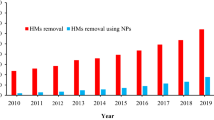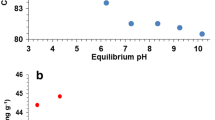Abstract
The effect of nanotechnology on cadmium and zinc removal from aqueous solution was investigated. In order to characterize micro and nano phragmites australis adsorbent, we analyzed the data via FTIR, SEM, PSA, and EDX. The effect of various parameters such as pH, contact time, amount of adsorbent and initial concentration, was investigated. The optimum pH for the removal of cadmium for micro and nano phragmites australis adsorbent was 7, and for the removal of zinc by the micro adsorbent was 7 and by nano adsorbent was 6. The equilibrium time of zinc was 90 min and for the adsorption of cadmium by micro and nano adsorbent were 90 and 30 min, respectively. The optimum dose of micro adsorbent for the removal of cadmium was 0.7 g, and the other dose for the removal of zinc and cadmium was 0.5 g. The evaluation of adsorbent’s distribution coefficient showed that the highest rates of distribution coefficient with initial concentration of 5, 10, 30, and 50 mg/L were 394.83, 587.62, 759.39 and 1101.52 L/kg, respectively, which were observed in nano adsorbent. Desorption experiments for the nano adsorbent in three cycles were done. Among kinetics models, our experimental data were more consistent with Hoo kinetic model and for isotherm models, Freundlich isotherm was more consistent. The results show that nanotechnology could increase the performance of adsorbents and enhance the efficiency of the adsorption of cadmium and zinc ions.
Similar content being viewed by others
References
OZCAN A, TUNALI S, AKAR T, KIRAN I. Determination of the equilibrium, kinetic and thermodynamic parameters of adsorption of copper(II) ions onto seeds of Capsicum annuum [J]. Journal of Hazard Mater, 2005, 124: 200–208.
PRASAD M, SAXENA S. Sorption mechanism of some divalent metal ions onto low-cost mineral adsorbent [J]. J Ind Eng Chem Res, 2004, 43: 1512–1522.
WANG F Y, WANG H, MA J W. Adsorption of cadmium(II) ions from aqueous solution by a new low-cost adsorbent Bamboo charcoal [J]. Journal of Hazardous Materials, 2010, 177: 300–306.
AYATI B, DELNAVAZ M, FARTOOS S. Evaluation of nanoparticle technology in environmental engineering [D]. Tehran: University of Amirkabeer, 2006.
HEGAZI H A. Removal of heavy metals from wastewater using agricultural and industrial wastes as adsorbents [J]. HBRC Journal, 2013, 9: 276–282.
SHAHEEN M S, FAWZY I E, KHALED M G H, HALA M G. Heavy metals removal from aqueous solutions and wastewaters by using various byproducts [J]. Journal of Environmental Management 2013, 128: 514–521.
SINGHA B, KUMAR DAS S. Adsorptive removal of Cu(II) from aqueous solution and industrial effluent using natural/agricultural wastes [J]. Colloids and Surfaces B: Biointerfaces, 2013, 107: 97–106.
EL-SADAAWY M, ABDELWAHAB O. Adsorptive removal of nickel from aqueous solutions by activated carbons from doum seed (Hyphaenethebaica) coat [J]. Alexandria Engineering Journal, 2014, 53: 399–408.
MATOUQ M, JILDEH N, QTAISHAT M, HINDEYEH M, AL SYOUF M Q. The adsorption kinetics and modeling for heavy metals removal from wastewater by Moringa pods [J]. Journal of Environmental Chemical Engineering, 2015, 608: 1–10.
SINGHA A S, GULERIA A. Utility of chemically modified agricultural waste okra biomass for removal of toxic heavy metal ions from aqueous solution [J]. Engineering in Agriculture, Environment and Food, 2015, 8(1): 52–60.
SMOLYAKOV B S, SAGIDULLIN A K, BYCHKOVB A L, LOMOVSKY I O, LOMOVSKY O I. Humic-modified natural and synthetic carbon adsorbents for the removal of Cd(II) from aqueous solutions [J]. Journal of Environmental Chemical Engineering, 2015, 3: 1939–1946.
SEN T K, GOMEZ D. Adsorption of zinc (Zn2+) from aqueous solution on natural bentonite [J]. Desalination, 2011, 267: 286–294.
LANGMUIR I. The adsorption of gases on plane surfaces of glass, mica and platinum [J]. J Am Chem Soc, 1918, 40: 1361–1368.
FREUNDLICH H. Adsorption in solution [J]. Phys Chem Soc, 1906, 40: 1361–1368.
SHAHEEN S M, TSADILAS C D, MITSIBONAS T, TZOUVALEKAS M. Distribution coefficient of copper in different soils from egypt and Greece [J]. Communications in Soil Science and Plant Analysis, 2009, 40: 214–226.
LAGERGREN S. Zur theorie der sogenannten adsorption geloster stoffe [J]. Kungliga Svenska Vetenskapsakademiens Handlingar, 1898, 24: 1–39. (in German)
HO Y S, MCKAY G, WASE D A J, FOSTER C F. Study of the sorption of divalent metal on to peat [J]. Adsorpt Sci Technol, 2000, 18: 639–650.
WEBER W J, MORRIS J C. Kinetics of adsorption on carbon from solution [J]. J Sanit Eng Div Am Soc Civ Eng, 1963, 89: 31–60.
HAMEED B H, EL-KHAIARY M I. Equilibrium, kinetics and mechanism of malachite green adsorption on activated carbon prepared from bamboo by K2CO3 activation and subsequent gasification with CO2 [J]. Journal of Hazardous Materials, 2008, 157: 344–351.
JAGUARIBE E F, MEDEIROS L L, BARRETO M C S, ARAUJO L P. The performance of activated carbons from sugarcane bagasse, and coconut shells in removing residual chlorine [J]. Brazilian Jowrnal of Chemical Engineering, 2005, 22(1): 41–47.
AFKHAMI A, TEHRANI M S, BAGHERI H. Simultaneous removal of heavy-metal ions in wastewater samples using nano-alumina modified with 2, 4-dinitrophenylhydrazine [J]. Journal of Hazardous Materials, 2010, 181: 836–844.
BESTANI B, BENDERDOUCHE N, BENSTAALI B, BELHAKEM M, ADDOU A. Methylene blue and iodine adsorption onto an activated desert plan [J]. Bio Resource Technology, 2008, 99: 8441–8444.
FARASATI M, SEYEDIAN M, BOROOMANDNASAB S, JAAFARZADEH N, MOAZED H, GHAMARNIA H. Batch and column studies on the evaluation of micrometer and nanometer Phragmites australis for nitrate removal [J]. Desalination and Water Treatment, 2013, 51: 28–30.
GUPTA S S, BHATTACHARYA K G. Immobilization of Pb (II), Cd (II) and Ni (II) ions on kaolinite and montmorillonite surfaces from aqueous medium [J]. Journal of Environmental Management, 2008, 87: 46–58.
KUMAR U, BANDYOPADHYAY M. Sorption of cadmium from aqueous solution using pretreated rice husk [J]. Bio Resource Technology, 2006, 97(1): 104–109.
THAVAMANI S H, RAJKUMAR S R. Removal of Cr(VI), Cu(II), Pb(II) and Ni(II) from aqueous solutions by adsorption on alumina [J]. Research Journal of Chemical Sciences, 2013, 3(8): 44–48.
ANIRUDHAN T S, SREEKUMARI S. Adsorptive removal of heavy metal ions from industrial effluents using activated carbon derived from waste coconut buttons [J]. Journal of Environmental Sciences, 2011, 23(12): 1989–1998.
Author information
Authors and Affiliations
Corresponding author
Rights and permissions
About this article
Cite this article
Kahrizi, H., Bafkar, A. & Farasati, M. Effect of nanotechnology on heavy metal removal from aqueous solution. J. Cent. South Univ. 23, 2526–2535 (2016). https://doi.org/10.1007/s11771-016-3313-8
Received:
Accepted:
Published:
Issue Date:
DOI: https://doi.org/10.1007/s11771-016-3313-8




